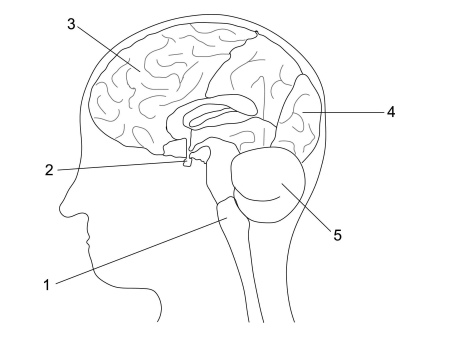Which labelled structure on the diagram of the brain plays the major role in regulating the nervous control of heart rate?

A. 1
B. 3
C. 4
D. 2
E. 5
Which labelled structure on the diagram of the brain plays the major role in regulating the nervous control of heart rate?

A. 1
B. 3
C. 4
D. 2
E. 5
The correct answer is A.
Item 1 refers to the medulla oblongata
It is located at the lower part of the brain, and helps transfer information from the brain to the spinal cord. Most importantly, it controls life sustaining functions like the heart rate, blood pressure or breathing.
The nerve signals indicating the CO2 and pH levels on the aorta are sent to the medulla, which then triggers the contraction of intercostal muscles and the diaphragm, and inducing respiration.
Item 2 refers to the pituitary gland
The pituitary gland, or hypophysis, is found at the base of the brain. It can be divided into 2 distinct structures that have different embryological origins : anterior and posterior hypophysis.
Both lobes are made of different cells that ultimately secrete hormones, such as hCG, gonadotropins and ADH. These hormones play key roles in growth, reproduction and metabolism.
Item 3 refers to the cerebrum
The cerebrum is the biggest part of the brain. It is composed of 2 hemispheres. It plays key roles in many functions, like speech, thinking, initiation of movements, and memory.
Item 4 refers to the occipital lobe
The occipital lobe plays a key role in our vision : it is the area that processes depth and distance and also helps recognize colors or faces. In other words, it is the visuospatial processor of the brain.
Item 5 refers to the cerebellum
The cerebellum, located at the back of the brain, plays a key role in posture, tone and balance. It is also important for the coordination of fine movements.
The cerebellum receives different proprioceptive information, which is information regarding the position and movement of the body. Through its connection to the spinal cord and brainstem, a motor command is generated. The movement is consistently regulated by corrective signals to ensure smooth and coordinated movement.